Case Study - Using Eyewear QC to Effectively Reduce Defects
A Case Study to show you exactly how you can take control of your eyewear quality. Take a look at current industry QC reports from PEL and what to expect from a thorough Eyewear QC process.
A Case Study to show you exactly how you can take control of your eyewear quality. Take a look at current industry QC reports from PEL and what to expect from a thorough Eyewear QC process.
Download the pdf version of this page and read it anytime at your leisure

Eyewear professionals need to understand the importance of quality testing eyewear before it’s put on the market. Regardless if you’re buying eyewear from a supplier or manufacturing your own eyewear, it’s imperative that you familiarize yourself with best-in-class eyewear quality control procedures, testing and best practices. Especially since there's an ever growing demand for high-end eyewear. This case study takes a look at real and current examples from PEL, including actual test results, QC reports, and outcomes. You’ll gain valuable insight into what goes into the eyewear QC process, what exactly gets tested, and what you can expect from a report.
Factories in China produce excellent quality eyewear and, for the most part, have their quality control procedures up to international standards, but that doesn’t mean that there won’t ever be issues as you’ll see in the conclusion of this case study. And what do you do when an Eyewear manufacturer in China screws up your order?
There are numerous reasons for using a third party QC inspection company, like:
Despite all these, the main reason for using a third party inspection company is to assure the eyewear order you receive meets the exact requirements you specified in your PO.
Regardless of how well acquainted you are with a factory and the staff you communicate with, you need to keep your finger on the pulse to assure the quality of your eyewear. This is one area in the eyewear trade you have to be proactive with and can’t leave in the hands of people not directly employed by your company.
Which begs the question - what exactly goes into an eyewear QC inspection, what is reported, how often is it reported, how responsive should your 3rd Party inspection company be? Can you do the QC testing yourself? What is included in a report?
This case study takes you through the eyewear QC process as done by PEL. We list the wide variety of tests available for eyewear QC, according to different standards (i.e., EU or U.S.)

The goal of this case study is to show you how you could benefit from third-party inspection, what a QC report looks like, the different tests you can perform on your eyewear and why it’s important to make sure your eyewear quality is up to standard.
Let’s dive straight in and look at WHY strict Quality Control on your eyewear is crucial for success.

In a recent survey, more than 70% of foreign companies manufacturing eyewear in China indicated quality as their number one biggest challenge.
Good quality eyewear manufacturing in China isn’t hard to come by, considering you take the time to follow a tried-and-tested, best practice and industry standard QC process. If you choose to neglect the QC process or basic steps it could lead to:
Online Portals exist in all the major regions of the world to publicly warn consumer about unsafe, fake, defective or inadequate products that have entered the market, including eyewear. Like these sites in:
You do NOT want your company name to appear on any of these sites. Once your brand or company name is displayed on theses sites it’s a permanent black mark on your record. Which is exactly why it’s important to know How Eyewear Quality Inspection Can Put Your Brand Ahead of the Game
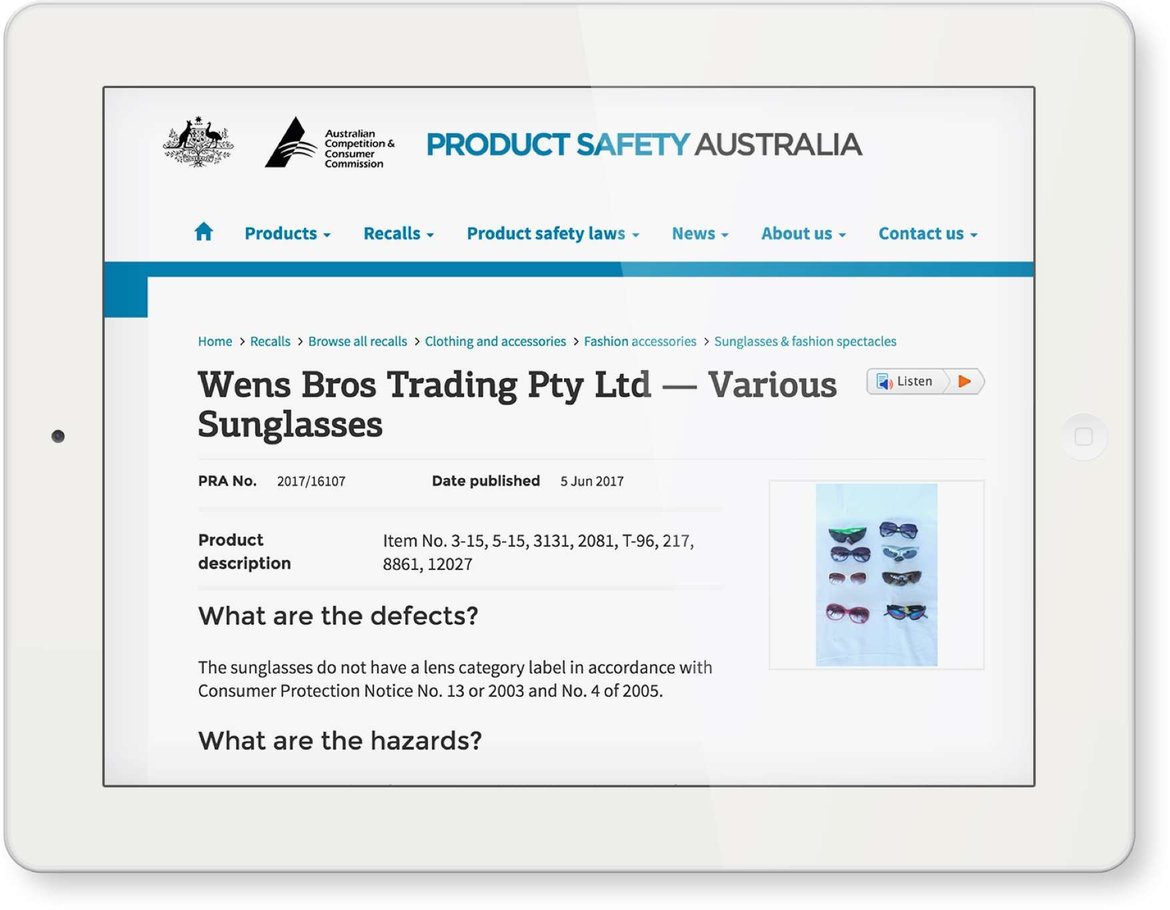
In this case, Wens Bros Trading’s downfall came down to something as simple as labeling, or the lack thereof, that resulted in a complete recall of an entire line of sunglasses.
Sunglasses are time sensitive, mostly seasonal, and often manufactured to match current fashion trends. Reordering or even relabelling would take too long, and we can assume that this recall resulted in significant financial losses which could have been easily avoided with the most basic quality inspection - visual inspection. You can read the full Wens Bros report here.
Which leads us to the next chapter to help you avoid similar mistakes, the Golden Sample.

Obtaining eyewear samples from your supplier/manufacturer is a step that some experienced eyewear companies choose to take before moving ahead with a new design.
Regardless of when product samples are requested, obtaining and approving the so-called “golden sample” can be paramount to setting your expectations for quality and eyewear requirements.
The golden sample is an approved sample, which is the factory’s attempt to manufacture a piece of eyewear as close to your requirements and specifications as possible. It’s crucial that these samples are established early on to serve as a model for mass production.
An approved sample clarifies the materials and parts required for your eyewear, such as the quality of the acetate used for the frames, or the plastic or glass that will be used for the lenses. It will benchmark the colors and labelling that then have to be matched by each piece of eyewear produced on the line.
The sample also serves as a clear standard for comparison for factory workers and any QC staff that may be inspecting the goods as they come off the production line. It’s not recommended to start production without golden samples approved and safely stored away.

It’s always a good idea to review a product sample and, if necessary, have a third party laboratory test the sample for approval.
Reviewing your eyewear sample may be as simple as checking dimensions and verifying Pantone colors. But, depending on the region in the world in which you plan to distribute your eyewear, lab testing might be required to verify that the substances used are safe for the end-users.
Another major concern is social compliance to verify that factory workers are being treated treated well and paid a fair wage, and in extreme cases don’t make use of child labor. Imagine the disastrous results if your eyewear company was suddenly associated with a factory exploiting child labor!
Only you can decide which testing is required for your product. If you’re unsure, a QC professional or lab such as PEL, that has experience with eyewear can tell you which tests are relevant and the estimated cost and time associated.
While most experienced importers are familiar with the value of obtaining and approving an eyewear master sample, they often overlook the importance of properly handling and keeping track of them.
How you handle approved samples is important because factory staff might misplace an approved sample or confuse it with an unapproved sample. Factories have been known to deliberately tamper with approved samples to obstruct the inspection process, especially when an outsourced third-party is expected to perform the inspection.
Factories that have something to hide don’t like third party inspection companies on-site and can go to extreme lengths to tarnish the reputation of the inspection party. This is why working with an experienced partner with a proven track record is the best move you could make to ensure you get the quality you need.
The danger in someone bungling your approved eyewear sample is that defects and nonconformities can occur in the finished products when factory workers refer to the incorrect sample for production. For example, the final approved color of sunglass lenses. If the wrong sample is used to compare color (especially color-enhancing sun lenses), the result could be mismatching lenses for thousands of pieces of eyewear.

The other main concern with fluffing product samples is that any of the staff managing the production line could end up using the wrong sample to mass-produce units, ultimately producing them according to incorrect standards.
When you encounter inspection results that don’t accurately represent an accurate situation at the factory, you’re more likely to make a misinformed decision about whether to ship that eyewear order.
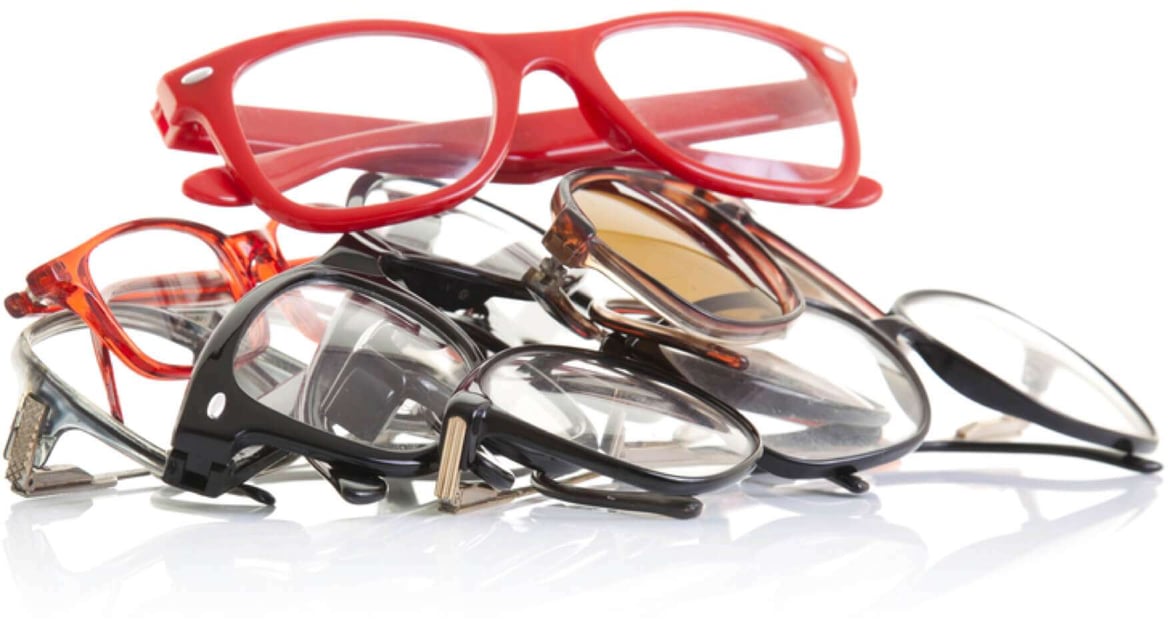
Send a sample to your supplier or factory well in advance before mass production starts; this will give them time to verify your requirements and ask for any clarification as required.
Send another sample to your inspection team at least a week in advance of the anticipated inspection date. Your approved samples can help you prevent product defects and catch any that might appear in your eyewear before shipping.
Now that you know the value of a golden sample and how it can assist you moving forward, we can move on to the next important tool to add to your toolbox - The QC Checklist will equip you with:
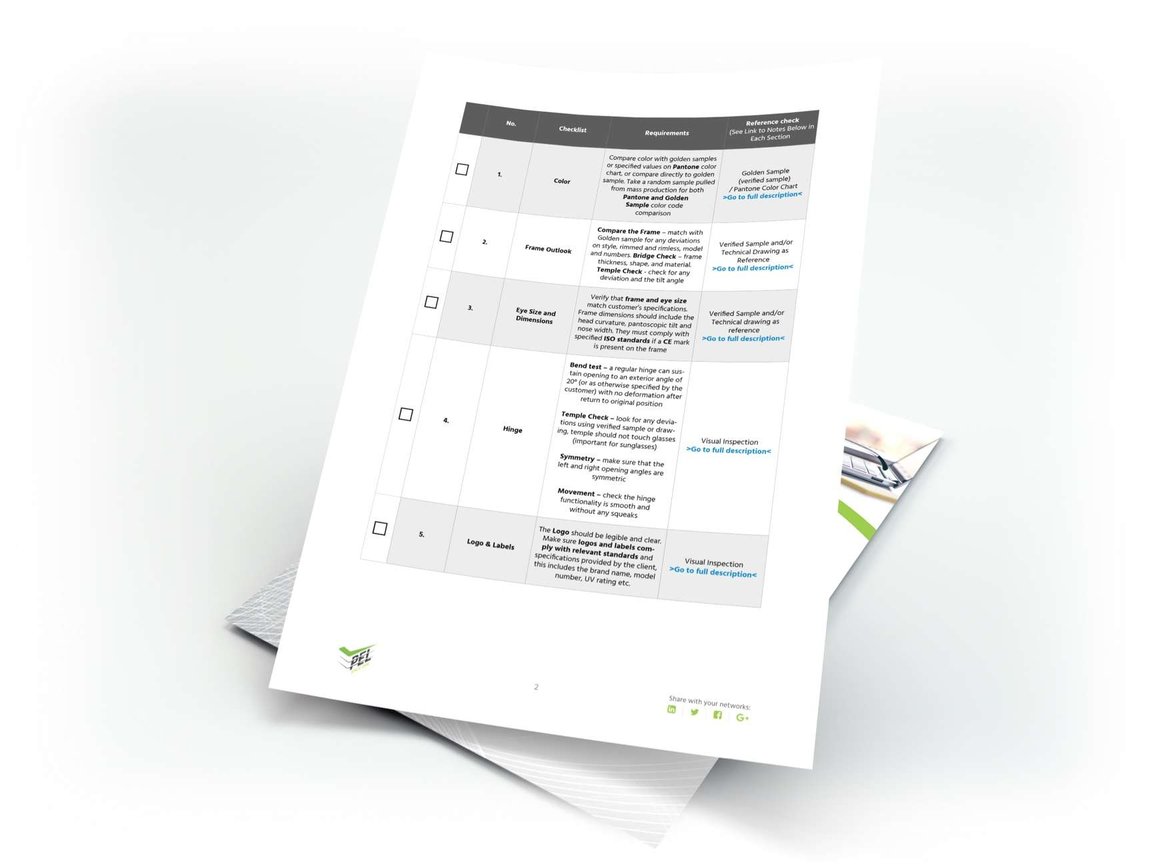
An Eyewear QC checklist is one of the most valuable documents for helping you limit quality defects in your eyewear. Checklists convey product requirements to the supplier/manufacturer and inspection criteria to QC staff. Here are the key areas that an Eyewear QC Checklist should address:
Both the workers manufacturing and the inspectors checking need these details to ensure your eyewear meets specifications. You could easily end up receiving defective or nonconforming goods if the factory has to guess your expectations (nothing should be left to speculation).
Packaging requirements commonly include points about carton material, logos, design, assortment method etc. Aside from protecting your fragile eyewear during transit, packaging also plays a large role in determining how customers perceive the final product; the entire eyewear market thrives on aesthetics after all.
Distributors reserve the right to refuse to stock your products if the factory fails to meet their packaging requirements.
In-house QC staff normally perform some on-site tests and checks on a product before the factory ships an order. This isn’t a requirement but rather a courtesy, so don’t expect it to be a thorough inspection. If your supplier or inspection staff aren’t aware of your exact requirements, you can’t be sure whether your eyewear will meet your safety, function or performance standards.

When compiling a list for which tests and checks to include in your Eyewear QC checklist, be sure to include the following:
Classifying defects makes it easier for you and your supplier to interpret the QC inspection results and determine whether an order meets your quality standards. QC professionals usually broadly classify eyewear defects into one of the following three types in order of severity:
Since importers probably have a different tolerance for each of the three defect types above, the maximum number of defects allowed for each lot tested will also vary for each type.
These different limits will impact the result of inspection and the importer’s decision to accept or reject the order. By clearly separating known eyewear defects (PEL keeps a list that we update monthly) by defect type in your QC checklist, you can improve the accuracy of your inspection reports and address any issues found.
PEL designed a comprehensive checklist to benchmark your QC process, you can find the full checklist here:

Exactly what you test in an eyewear inspection is largely dependent on the type of eyewear and the final destination. What follows is a detailed breakdown of the stages of inspection, and why each inspection stage is important or beneficial.
IPQC is materials/components quality in-process inspection.
In-process QC allows you real-time updates of what is happening with the manufacturing of your eyewear. If any serious problems are found at this stage you will be able to react immediately which will allow you to prevent delays with the original lead time, or any nasty surprises like spelling mistakes (as trivial as this may sound this is an actual and persisting issue, and on that is easy to avoid).
Inspectors pick up samples from the production line or inventory during production to check whether the workflow fits the operation guidance and product quality meets the client’s requirements. In addition, the factory's production capacity, internal quality control, and material control are inspected.
This ties in with in-process QC and also allows you to be reactive with solutions to any problems that might occur.
Inspectors handle the inspection and filing of relevant production documents for preliminary inspection and authentication. When facing queries from state authority departments or other controversies, the files listed below can be accessed at any time:
Technical document inspection by a third party is valuable because it will save you the time and effort of sifting through all the documents in Chinese. The QC company is well equipped to handle all the documentation for you as they do this on a regular basis and know what to look for. You will receive a report in English to verify that all the relevant documentation is in place and you can simply tick the boxes.
In order to meet customers’ specific inspection requirements PEL also offer customized testing services from In-Process Quality Control (IPQC), During Production Inspection (DUPRO), through to process monitoring during the entire supply chain. Custom inspections are useful due to the fact that you can single out specifically what you’d like tested, saving on cost and time. For example, the QC testing on metal frames won’t be the same as that of Acetate frames. On top of the usual durability tests performed on both these frames, metal frames will also be tested for corrosion, checking the thickness and quality of the plating on the frames to ensure the quality is up to standard. Where acetate frames will be isolated to test whether the acetate has been stored properly before production and won’t damage the lenses during shipping.
Once you know the components of the eyewear you’ll be testing you can create a customized test to match the requirements of the eyewear’s final destination.
Obtaining eyewear samples from your supplier/manufacturer is a step that some experienced eyewear companies choose to take before moving ahead with a new design.
Regardless of when product samples are requested, obtaining and approving the so-called “golden sample” can be paramount to setting your expectations for quality and eyewear requirements.
The golden sample is an approved sample, which is the factory’s attempt to manufacture a piece of eyewear as close to your requirements and specifications as possible. It’s crucial that these samples are established early on to serve as a model for mass production.
An approved sample clarifies the materials and parts required for your eyewear, such as the quality of the acetate used for the frames, or the plastic or glass that will be used for the lenses. It will benchmark the colors and labelling that then have to be matched by each piece of eyewear produced on the line.
The sample also serves as a clear standard for comparison for factory workers and any QC staff that may be inspecting the goods as they come off the production line. It’s not recommended to start production without golden samples approved and safely stored away.

PSI, performed when goods are 100% completed and ready for shipment, protects importers from international trade risks. Inspectors randomly check samples of finished goods, adhering to the international statistical standard: ISO 2859-1 Finished products are confirmed in full compliance with each customer’s specifications.
PSI covers product quantity, functions, safety, type, color, general appearance, size and outer packaging, etc. After inspection, customers receive an inspection report attached with particular photographs for their final decision (as illustrated in the example report below).
Pre-shipment inspection ensures that all the aspects of your order are in place, loaded and ready to go. After the final go-ahead from the QC company you will be able to sign off on the order and finalise payment (depending on how the payment was structured) and move on to obtaining all the relevant shipping documents.
If the eyewear is damaged after this point you will be able to single out the culprits with both photographic evidence of neatly loaded stock and a verified QC report, which will give you the upper hand legally in the event anything goes wrong.
While most experienced importers are familiar with the value of obtaining and approving an eyewear master sample, they often overlook the importance of properly handling and keeping track of them.
How you handle approved samples is important because factory staff might misplace an approved sample or confuse it with an unapproved sample. Factories have been known to deliberately tamper with approved samples to obstruct the inspection process, especially when an outsourced third-party is expected to perform the inspection.
Factories that have something to hide don’t like third party inspection companies on-site and can go to extreme lengths to tarnish the reputation of the inspection party. This is why working with an experienced partner with a proven track record is the best move you could make to ensure you get the quality you need.
The danger in someone bungling your approved eyewear sample is that defects and nonconformities can occur in the finished products when factory workers refer to the incorrect sample for production. For example, the final approved color of sunglass lenses. If the wrong sample is used to compare color (especially color-enhancing sun lenses), the result could be mismatching lenses for thousands of pieces of eyewear.
Below is a table illustrating the variety of standards eyewear have to adhere to in different regions of the world. PEL perform quality control based on the final destination and the standard specified by the client. If the client is unsure of which standards to follow PEL can advise.
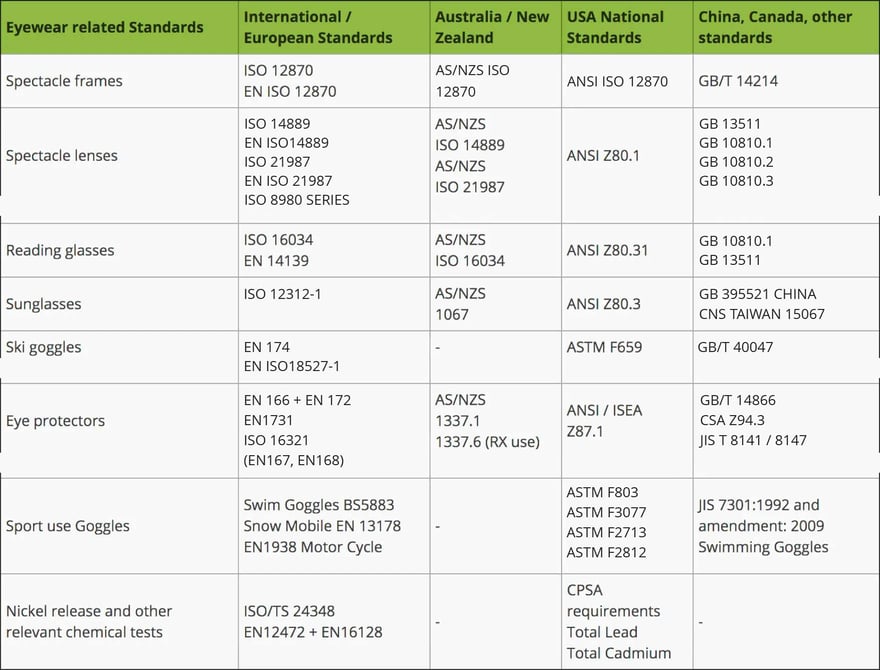

This case study takes a look at the production of Sunglasses for a PEL client, Europe was the final destination, and EN ISO 12312-1:2013 was used as the quality standard, with a summary of the results at the end of the report.
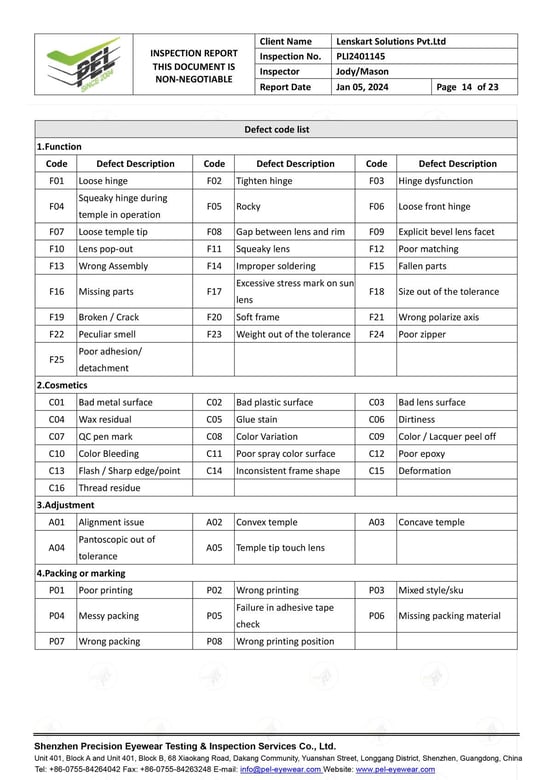
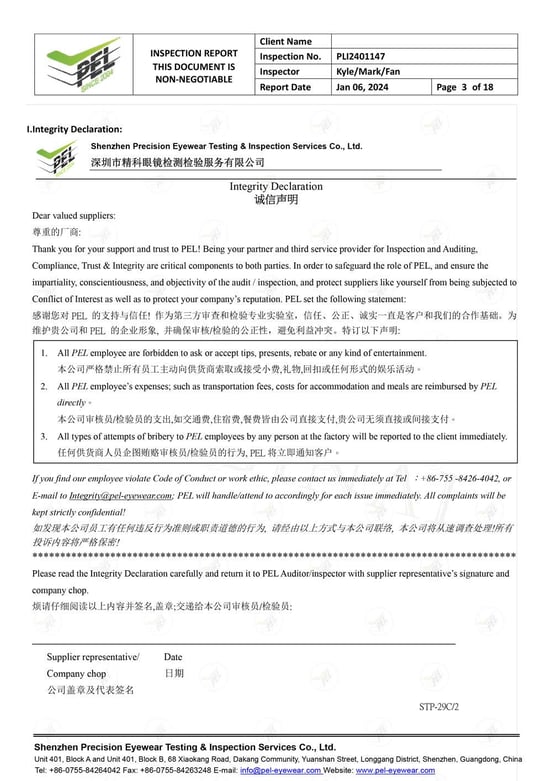
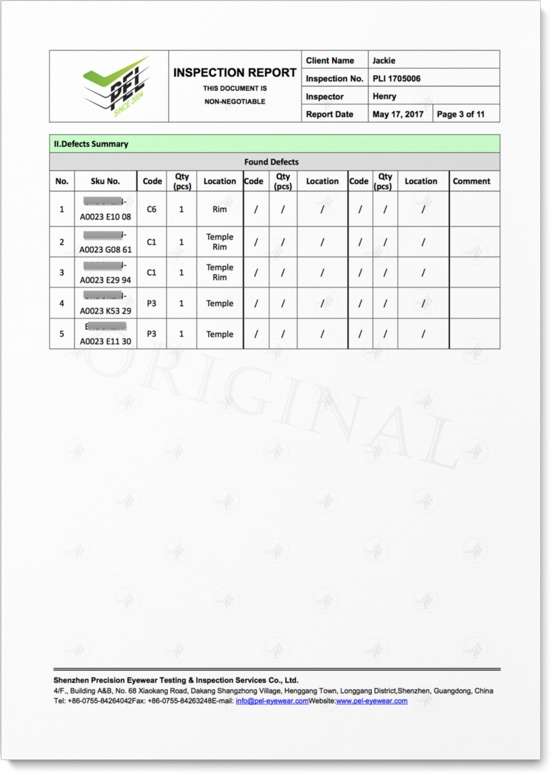
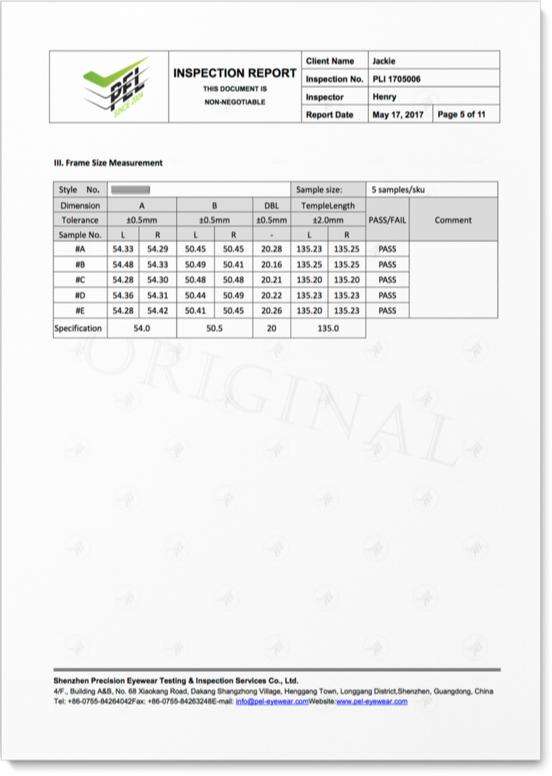
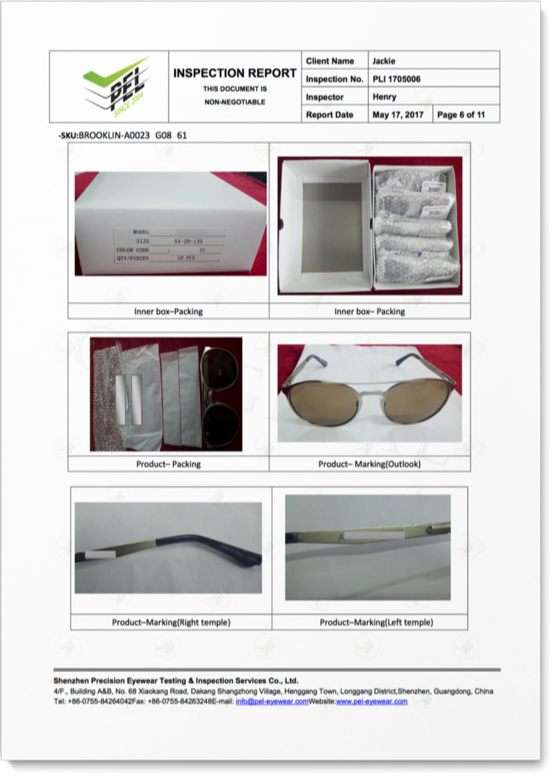
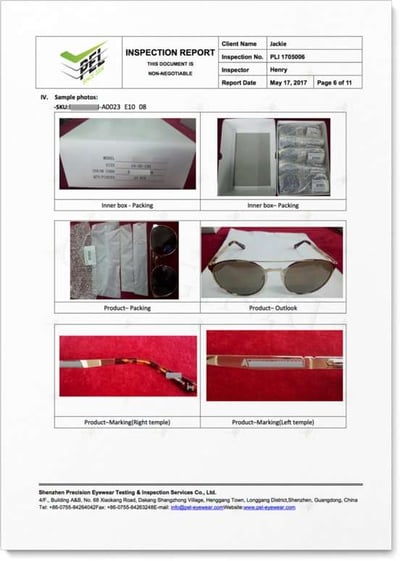
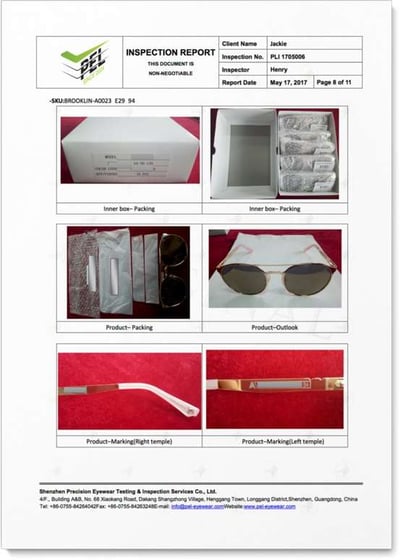
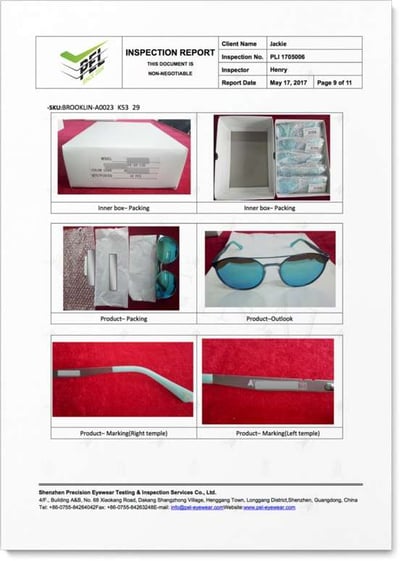
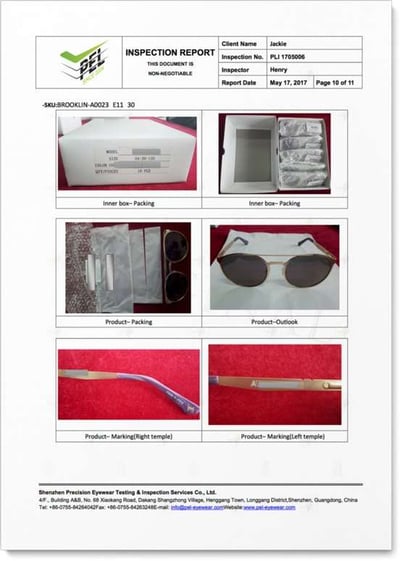
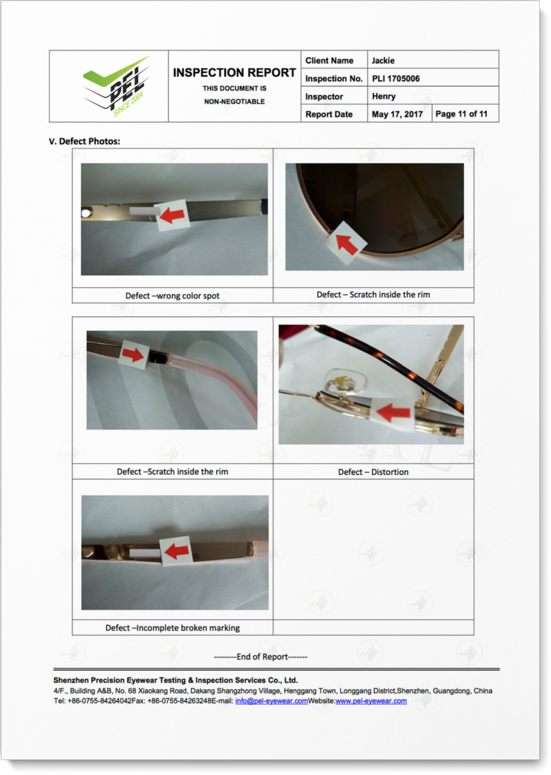
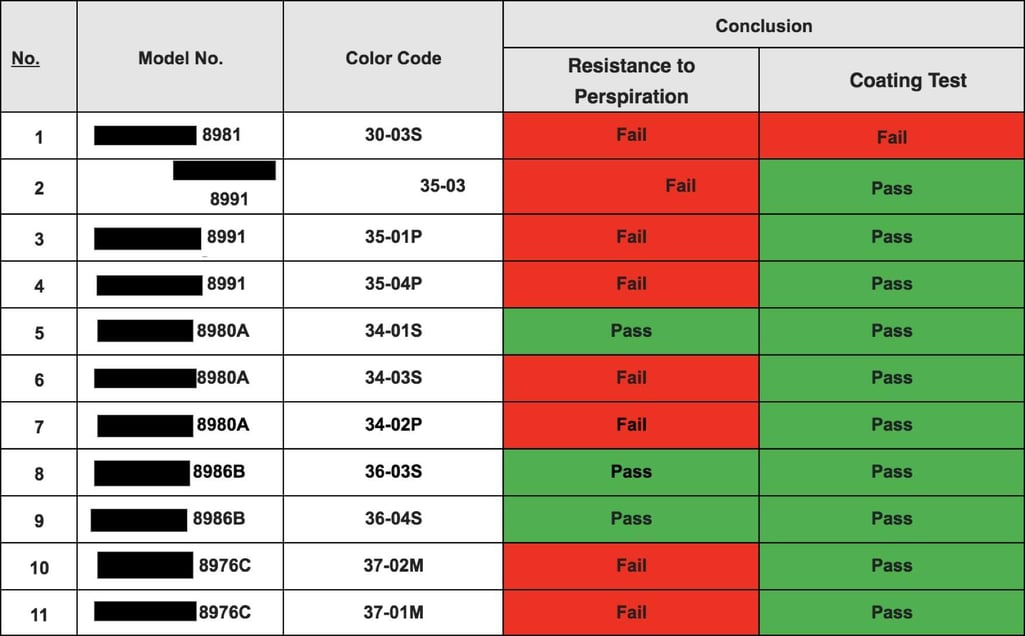
In the case above we found that the factory did, in fact, use similar testing procedures as PEL, however, they neglected to test the complete frame.
PEL performed QC tests as per ISO 12870 standards and found that the metal parts of the frames were corroding near the acetate pieces of the frame after approximately 24 hours.
Acetate, as the name suggests, is acid based and if the coatings or plating on the frames aren't of good quality (which was the case in this instance), the acid will attack the surface of the frames which will result in severely damaged eyewear, ultimately resulting in unacceptable quality unfit for retail.
PEL suggested that the frames either be re-plated with Palladium or that the client source a higher quality coating with strong anti-acid attributes to recoat the frames. The client opted for PEL’s preferred recommendation and sourced a high quality imported lacquer to recoat the frames, ultimately saving the entire shipment of eyewear.
The factory performed an in-house quality test or any flaws on the frames but neglected to perform a complete inspection. In all likeliness, this would have resulted in a severe loss of revenue to PEL’s client if the quality issues weren’t discovered in time. Which again highlights the importance of thorough third party quality inspection and factory auditing
We hope you found this case study helpful and that it will serve you well in your eyewear endeavors in the future. Now you too can assess whether this tried-and-tested eyewear QC testing framework is suitable for your products. If you are currently experiencing quality issues, it may be that implementing some of the testing described here could solve the problems, or that it becomes apparent that working with a 3rd party inspector is the way forward.
Undeniable Proof That Eyewear Quality Standards Are Still Important
The quality of your eyewear directly represents the image of the quality of your company! Eyewear quality standards matter, and here's why.....Read more
The Case for and Against Blue Light Blocking Glasses
What is blue light, what does the research say and why should your company be in the know? We look at recent studies and weigh up all the facts to see if your blue light blocking glasses are doing what they claim in the sales pitch.
What To Do When Eyewear Manufacturers in China Screw up Your Order
What do you do when eyewear manufacturers in China screw up your eyewear order, what legal grounds do you have? Find out here.....Read more
The Best Eyewear Manufacturers in China, and How to Source Them
Sourcing eyewear from China? Everything you need to find the best eyewear manufacturers in China.....Read more
How Eyewear Quality Inspection Can Put Your Brand Ahead of the Game
Need to control the quality of the eyewear you manufacture in China, ensure you manufacture eyewear without defects......Read more
The True Cost of Eyewear Quality Control - Why it Saves You Money
What is Eyewear Quality Control and where can you learn more about it? Gain the insight you need to beat competition in both pricing and quality......Read more
Unit 401, Block A and Unit 401, Block B, 68 Xiaokang Road,
Dakang Community, Yuanshan Street,
Longgang District, Shenzhen, P.c. 518115
Phone: +86 0755 84264042